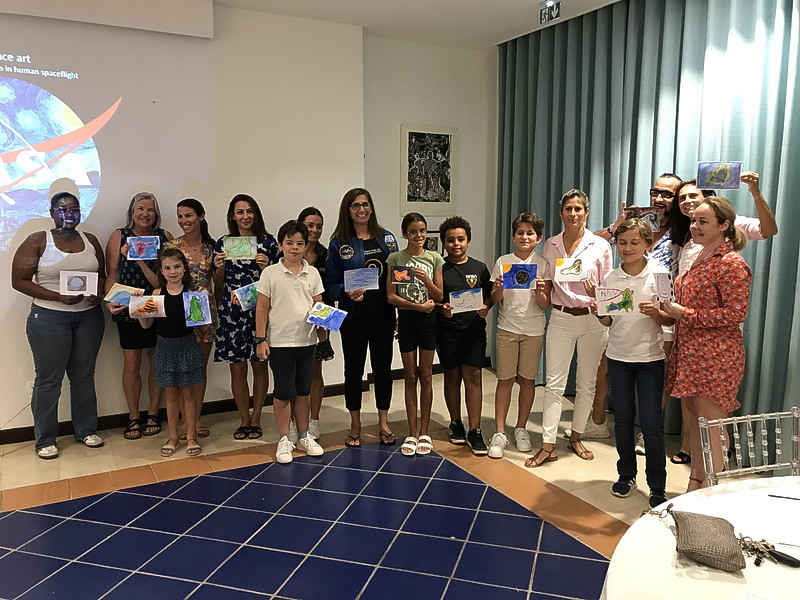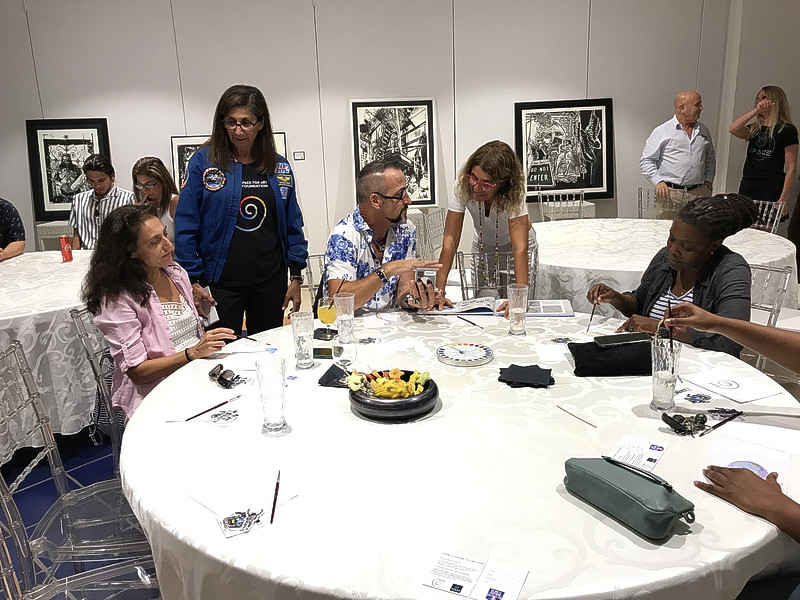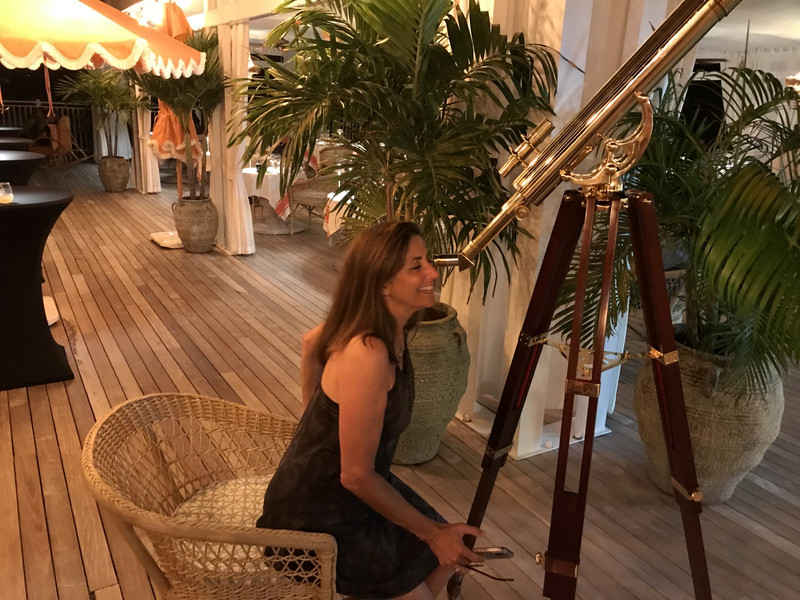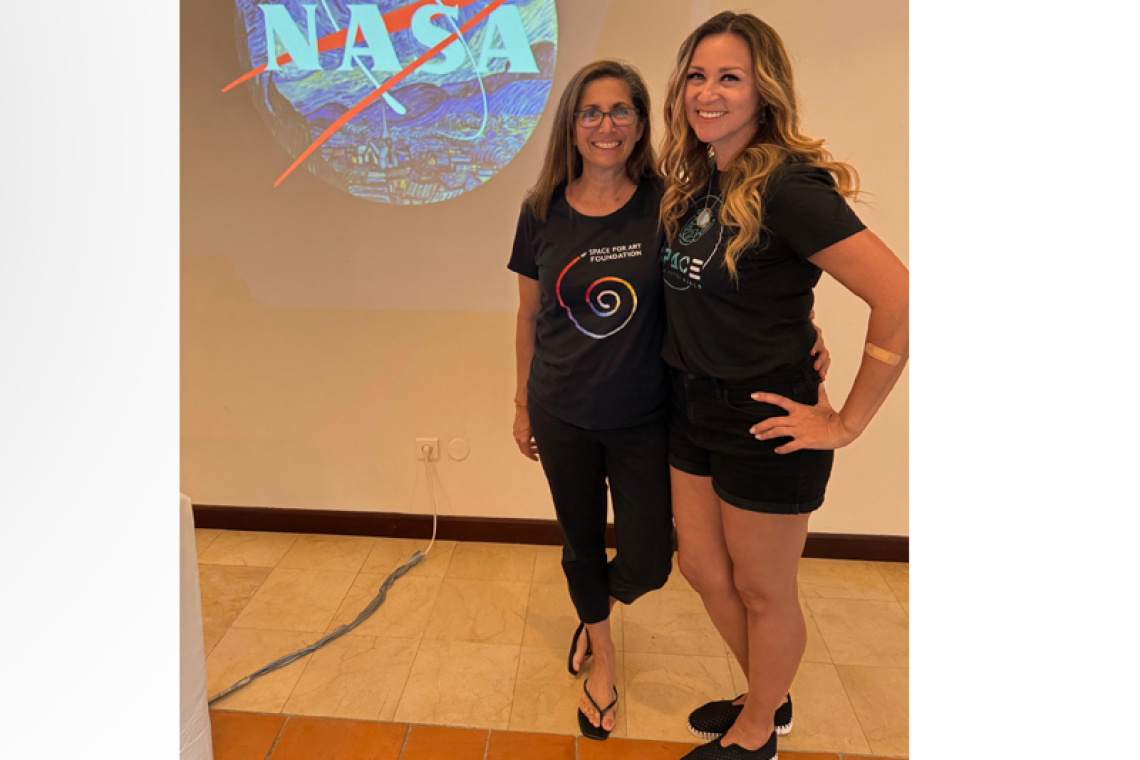Astronaut Nicole Stott (left) with Cristina Korp at Belmond La Samanna.
MARIGOT--Belmond La Samanna Hotel was honoured to host astronaut Nicole Stott November 28-30, where she brought a fascinating and unique insight to her experience of working at the National Aeronautical Space Agency (NASA), and her two flight missions to the International Space Station (ISS) in 2009 and 2011.
 Nicole Stott (centre) poses with the children and adults who took part in the painting workshop in Rendez-vous Pavilion. (Robert Luckock photo)
Nicole Stott (centre) poses with the children and adults who took part in the painting workshop in Rendez-vous Pavilion. (Robert Luckock photo)

Nicole Stott (standing) peruses art work during the workshop in Rendez-vous Pavilion on Wednesday. (Robert Luckock photo)

Nicole Stott looking through one of the two telescopes. (Robert Luckock photo)
Nicole first worked at NASA as a flight engineer on a special plane, training astronauts how to land the space shuttle, before two years later she was selected for astronaut candidate training in the class of 2000. At that time there were 9,000 applicants. Nicole was one of 17 selected in her class.
This event was a rare opportunity to meet an astronaut in person. Nicole’s earthly mission is to promote her Space for Art Foundation and she was joined by Astronaut Wrangler Christina Korp, founder of Space for a Better World. The pair describe themselves as partners with purpose. Their team also carries out giant space artwork projects around the world and work with children in hospitals, refugee centres and orphanages.
During the first evening Nicole shed light on life in space and under the water, as well as her rituals before missions and key lessons on sustainability.
On Wednesday in the Rendezvous Pavilion, she hosted an interactive art workshop for children and adults, bringing the cosmos to life on canvas. Most of the children taking part were children of hotel employees or of hotel guests. Sir Roland Richardson and wife Laura were present, as was driftwood sculptor Alain Jouet to offer guidance.
“Space and art don’t sound like two things that should go together,” she said, before walking the audience through videos of artworks that have been done in the international space station, including a water colour painting she did of a photographic image from the space station window that to her resembled a wave. It was a tiny chain of islands off Venezuela called Los Roques.
“I printed the image on a scrap of paper and stuck it to the wall and painted. Remember, you have to be very organised because everything is floating.” A close up of St. Maarten from space was also shown for painting inspiration.
The space station orbits the earth every 90 minutes at 17,500mph, or five miles per second, 16 times a day.
A surprising footnote to the artwork session was “Postcards for Space”. Artwork can be painted on one side of a postcard, the painter’s address filled in on the other side. The postcards are then
sent to a company called Blue Origin which sends the postcards into space. The postcards come back stamped “Flown in Space” and sent back to the address on the card as proof it went into space.
Christina said she is passionate about music and art. Originally she wanted to be a rock star, but ended up working in the space world for several years for astronaut Buzz Aldrin, the second man who walked on the moon, and was responsible for his legacy. “I think everyone carries their dreams and hopes in the moon and the stars, so it’s not a big stretch of the imagination to think about art and space together and that is what united us. Nicole and I have a very conscious goal and mission of using art to inspire people, so I’m very proud to work with her and we do projects all over the world with kids.”
Nicole explained the common misconception about astronauts and scientists is that everything about them is very technical when in fact many astronauts are also musicians and artists.
“Everyone that I met, from astronauts, at Mission control, the people training us, the scientists, they all had a creative outlet. We like to talk about space art from the standpoint of putting the human in space flight.”
Nicole’s first flight to the ISS in 2009 was on a night launch on the space shuttle Discovery and she spent three months on the station. She returned on Atlantis. Her second flight in 2011 turned out to be the last mission for Discovery. This time she spent only two weeks on the station.
She described in detail living on the “football field-sized” space station as a flight engineer, living off the grid, carrying out scientific tasks, bonding with crew-mates, problem solving, and how everything floats. “I knew I could trust every one of the crew, that they had my back, and in turn I had their back.”
Aside from drawing or painting in space, there have been musical instruments taken up to space during the Gemini mission, also bells and harmonica on a Christmas mission. One astronaut even played “Amazing Grace” on the bagpipes as a memorial tribute to a friend who passed away on Earth. Having a camera to take shots of Earth from the seven windows has always been essential.
“The sight of Earth, the incredible colours, nothing prepares you for it. It’s overwhelming to see,” said Nicole.
Asked what her first experience of a launch was like, she replied. “You’re anxious, but not in a terrified way. Nothing prepares you for how dynamic it is. You are curious to know what seven million pounds of exploding rocket underneath you feels like. One moment you are sitting on the launch pad with all that shaking energy and eight minutes later you are orbiting the earth. In the training you simulate everything as much as possible. But to float and fly in that environment, you’re not prepared for that.”
And for the re-entry to Earth? “From the times the engines burn and you re-enter earth’s atmosphere, it’s one hour. On the space shuttle it was so comfortable, so graceful, a little bumpy here and there. Yes, you do see all the plasma outside the window. Then you’re landing on the runway.”
The last evening was a celestial dinner evening under the stars at La Plaj Restaurant with Nicole’s family and invited guests. Two elaborate telescopes on loan from Belmond Cap Juluca enabled everyone to see Saturn and Jupiter, and other stars, up close, when cloud cover permitted.







